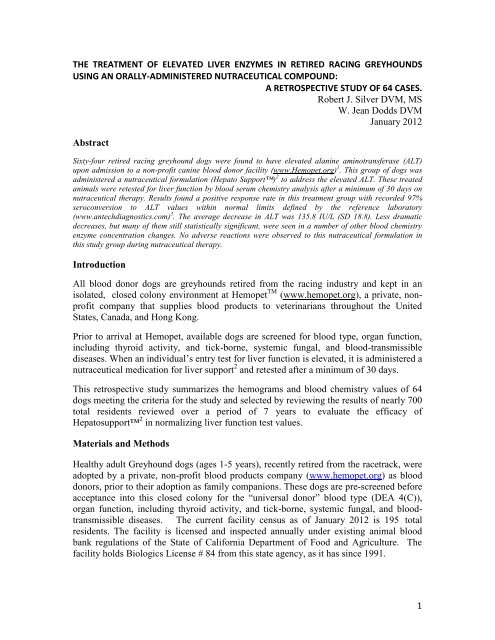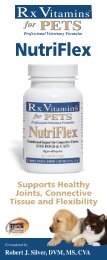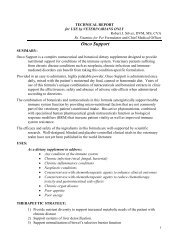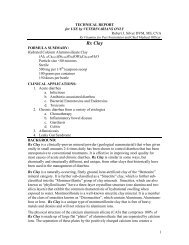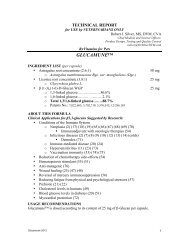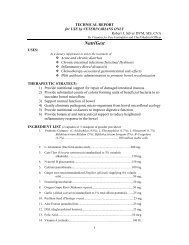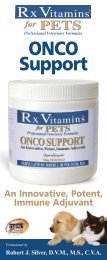1 the treatment of elevated liver enzymes in retired ... - RX Vitamins
1 the treatment of elevated liver enzymes in retired ... - RX Vitamins
1 the treatment of elevated liver enzymes in retired ... - RX Vitamins
You also want an ePaper? Increase the reach of your titles
YUMPU automatically turns print PDFs into web optimized ePapers that Google loves.
THE TREATMENT OF ELEVATED LIVER ENZYMES IN RETIRED RACING GREYHOUNDS<br />
USING AN ORALLY-ADMINISTERED NUTRACEUTICAL COMPOUND:<br />
A RETROSPECTIVE STUDY OF 64 CASES.<br />
Robert J. Silver DVM, MS<br />
W. Jean Dodds DVM<br />
January 2012<br />
Abstract<br />
Sixty-four <strong>retired</strong> rac<strong>in</strong>g greyhound dogs were found to have <strong>elevated</strong> alan<strong>in</strong>e am<strong>in</strong>otransferase (ALT)<br />
upon admission to a non-pr<strong>of</strong>it can<strong>in</strong>e blood donor facility (www.Hemopet.org) 1 . This group <strong>of</strong> dogs was<br />
adm<strong>in</strong>istered a nutraceutical formulation (Hepato Support) 2 to address <strong>the</strong> <strong>elevated</strong> ALT. These treated<br />
animals were retested for <strong>liver</strong> function by blood serum chemistry analysis after a m<strong>in</strong>imum <strong>of</strong> 30 days on<br />
nutraceutical <strong>the</strong>rapy. Results found a positive response rate <strong>in</strong> this <strong>treatment</strong> group with recorded 97%<br />
seroconversion to ALT values with<strong>in</strong> normal limits def<strong>in</strong>ed by <strong>the</strong> reference laboratory<br />
(www.antechdiagnostics.com) 3 . The average decrease <strong>in</strong> ALT was 135.8 IU/L (SD 18.8). Less dramatic<br />
decreases, but many <strong>of</strong> <strong>the</strong>m still statistically significant, were seen <strong>in</strong> a number <strong>of</strong> o<strong>the</strong>r blood chemistry<br />
enzyme concentration changes. No adverse reactions were observed to this nutraceutical formulation <strong>in</strong><br />
this study group dur<strong>in</strong>g nutraceutical <strong>the</strong>rapy.<br />
Introduction<br />
All blood donor dogs are greyhounds <strong>retired</strong> from <strong>the</strong> rac<strong>in</strong>g <strong>in</strong>dustry and kept <strong>in</strong> an<br />
isolated, closed colony environment at Hemopet TM (www.hemopet.org), a private, nonpr<strong>of</strong>it<br />
company that supplies blood products to veter<strong>in</strong>arians throughout <strong>the</strong> United<br />
States, Canada, and Hong Kong.<br />
Prior to arrival at Hemopet, available dogs are screened for blood type, organ function,<br />
<strong>in</strong>clud<strong>in</strong>g thyroid activity, and tick-borne, systemic fungal, and blood-transmissible<br />
diseases. When an <strong>in</strong>dividual’s entry test for <strong>liver</strong> function is <strong>elevated</strong>, it is adm<strong>in</strong>istered a<br />
nutraceutical medication for <strong>liver</strong> support 2 and retested after a m<strong>in</strong>imum <strong>of</strong> 30 days.<br />
This retrospective study summarizes <strong>the</strong> hemograms and blood chemistry values <strong>of</strong> 64<br />
dogs meet<strong>in</strong>g <strong>the</strong> criteria for <strong>the</strong> study and selected by review<strong>in</strong>g <strong>the</strong> results <strong>of</strong> nearly 700<br />
total residents reviewed over a period <strong>of</strong> 7 years to evaluate <strong>the</strong> efficacy <strong>of</strong><br />
Hepatosupport 2 <strong>in</strong> normaliz<strong>in</strong>g <strong>liver</strong> function test values.<br />
Materials and Methods<br />
Healthy adult Greyhound dogs (ages 1-5 years), recently <strong>retired</strong> from <strong>the</strong> racetrack, were<br />
adopted by a private, non-pr<strong>of</strong>it blood products company (www.hemopet.org) as blood<br />
donors, prior to <strong>the</strong>ir adoption as family companions. These dogs are pre-screened before<br />
acceptance <strong>in</strong>to this closed colony for <strong>the</strong> “universal donor” blood type (DEA 4(C)),<br />
organ function, <strong>in</strong>clud<strong>in</strong>g thyroid activity, and tick-borne, systemic fungal, and bloodtransmissible<br />
diseases. The current facility census as <strong>of</strong> January 2012 is 195 total<br />
residents. The facility is licensed and <strong>in</strong>spected annually under exist<strong>in</strong>g animal blood<br />
bank regulations <strong>of</strong> <strong>the</strong> State <strong>of</strong> California Department <strong>of</strong> Food and Agriculture. The<br />
facility holds Biologics License # 84 from this state agency, as it has s<strong>in</strong>ce 1991.<br />
1
All donor dogs are <strong>of</strong> blood type DEA 4(C) and are negative for all o<strong>the</strong>r known can<strong>in</strong>e<br />
red blood cell antigens, <strong>in</strong>clud<strong>in</strong>g DEA 1.1 (A1), DEA 1.2 (A2), and DEA 7 (Tr), <strong>the</strong><br />
antigens most associated with cl<strong>in</strong>ically significant transfusion <strong>in</strong>compatibilities <strong>in</strong> dogs.<br />
All donors receive on-site, 24 hour-a-day veter<strong>in</strong>ary care, socialization, and ma<strong>in</strong>tenance.<br />
All donor dogs are current on immunizations for can<strong>in</strong>e distemper, hepatitis,<br />
para<strong>in</strong>fluenza, leptospirosis, parvovirus, Bordetella, coronavirus and rabies virus.<br />
All donor dogs have been blood and serologically tested for can<strong>in</strong>e brucellosis,<br />
hemobartonellosis (hemoparasitic mycoplasma), Borrelia burgdorferi (Lyme disease),<br />
Dir<strong>of</strong>ilaria immitis (heartworm disease), Ehrlichia canis, Rocky Mounta<strong>in</strong> Spotted Fever,<br />
Leishmaniasis, Coccidioides immitis, Babesia canis, Babesia gibsoni, and plasma levels<br />
<strong>of</strong> von Willebrand factor.<br />
The subset <strong>of</strong> Hemopet colony dogs identified as hypothyroid, based on established<br />
diagnostic criteria for sight hounds, is treated with twice daily thyrox<strong>in</strong>e as prescribed by<br />
<strong>the</strong> veter<strong>in</strong>ary pr<strong>of</strong>essional staff. In cases where <strong>liver</strong> enzyme concentrations are <strong>elevated</strong>,<br />
<strong>the</strong> dogs are given nutraceutical support and treated with daily adm<strong>in</strong>istration <strong>of</strong> Hepato<br />
Support 2 .<br />
This retrospective study exam<strong>in</strong>ed blood tests kept on file at Hemopet for <strong>the</strong> residents <strong>of</strong><br />
this blood donor colony over a period <strong>of</strong> 7 years (2004-2011).<br />
Individuals were <strong>in</strong>cluded <strong>in</strong> this study if <strong>the</strong>ir blood tests upon entry to <strong>the</strong> colony had<br />
<strong>liver</strong> function tests at least 10% above <strong>the</strong> upper range <strong>of</strong> normal limits def<strong>in</strong>ed by <strong>the</strong><br />
reference laboratory that analyzed <strong>the</strong> blood samples (Antech Diagnostics) 3 .<br />
Study participants were adm<strong>in</strong>istered Hepato Support, a proprietary compounded<br />
nutraceutical formulation for <strong>liver</strong> support, and had <strong>the</strong>ir blood serum chemistries reevaluated<br />
after at least 30 days <strong>of</strong> <strong>the</strong>rapy.<br />
Statistical analysis was applied to <strong>the</strong> data by an <strong>in</strong>dependent statistical consultant 4 .<br />
Results<br />
64 dogs were <strong>in</strong>cluded <strong>in</strong> this study; 39 were neutered males, <strong>the</strong> o<strong>the</strong>r 22 were spayed<br />
females. Intact <strong>in</strong>dividuals were neutered upon entry to <strong>the</strong> blood donor facility to<br />
facilitate <strong>the</strong>ir social <strong>in</strong>tegration <strong>in</strong>to Hemopet’s closed colony.<br />
The average age <strong>of</strong> <strong>the</strong> dogs upon admission to <strong>the</strong> colony was 2.8 years (range 1 – 5).<br />
The average weight <strong>of</strong> <strong>the</strong>se Greyhounds was 32.5 kg (Range: 24.8 kg – 39.6 kg) The<br />
female dogs had an average weight <strong>of</strong> 29.1 kg (Range: 24.8 kg – 35.6 kg) and <strong>the</strong> male<br />
dogs an average weight <strong>of</strong> 34.3 kg (Range: 28.5 kg to 39.6 kg).<br />
The time between <strong>the</strong> first and second blood test<strong>in</strong>g occurred <strong>in</strong> <strong>the</strong> majority <strong>of</strong><br />
Greyhounds between 5-15 weeks (Range: 4-35 weeks) from <strong>the</strong> date <strong>of</strong> <strong>the</strong> <strong>in</strong>itial blood<br />
test<strong>in</strong>g.<br />
2
The changes <strong>in</strong> serum chemistry values were compared between <strong>the</strong> admission blood<br />
test<strong>in</strong>g and <strong>the</strong> follow-up blood test<strong>in</strong>g us<strong>in</strong>g paired t-tests. Hence, each dog served as<br />
his or her own control with <strong>the</strong> difference <strong>in</strong> values for each dog calculated and <strong>the</strong>n<br />
averaged.<br />
Table 1. displays a compilation <strong>of</strong> blood test values and <strong>the</strong> changes <strong>in</strong> <strong>the</strong>se values<br />
between <strong>the</strong> first and second blood draw determ<strong>in</strong>ations.<br />
TABLE 1.: Compilation <strong>of</strong> Blood Test Values<br />
Value<br />
% With Difference (1 st -2 nd ) p-value<br />
Decrease<br />
Total Prote<strong>in</strong> 61% 0.24 0.0007<br />
AST 75% 23.6 0.0072<br />
ALT 99% 139.7
Figure 1: ALT concentrations compared from <strong>the</strong> first to <strong>the</strong> second blood tests<br />
Discussion<br />
This study demonstrates that Hepato Support was effective <strong>in</strong> resolv<strong>in</strong>g naturally<br />
occurr<strong>in</strong>g <strong>elevated</strong> <strong>liver</strong> enzyme test concentrations <strong>in</strong> <strong>the</strong> <strong>retired</strong> rac<strong>in</strong>g Greyhound<br />
(RRG) dogs <strong>in</strong> this closed blood donor colony. Elevated <strong>liver</strong> enzyme concentrations are<br />
not common <strong>in</strong> <strong>the</strong> RRG, but can be a sign <strong>of</strong> endogenous <strong>liver</strong> disease, or tox<strong>in</strong> exposure<br />
and subsequent hepatocellular damage. O<strong>the</strong>r than blood chemistry analyses, no o<strong>the</strong>r<br />
attempt to fur<strong>the</strong>r diagnose <strong>the</strong> cause <strong>of</strong> <strong>the</strong> <strong>elevated</strong> ALTs <strong>in</strong> this donor colony was made<br />
s<strong>in</strong>ce <strong>the</strong> animals were outwardly <strong>in</strong> good health as determ<strong>in</strong>ed by thorough physical<br />
exam<strong>in</strong>ation by <strong>the</strong> pr<strong>of</strong>essional veter<strong>in</strong>ary staff on site, and <strong>elevated</strong> <strong>liver</strong> values<br />
normalized with such a high rate <strong>of</strong> efficacy follow<strong>in</strong>g <strong>the</strong> nutraceutical <strong>treatment</strong>.<br />
Rac<strong>in</strong>g Greyhounds are subjected to numerous stressors dur<strong>in</strong>g <strong>the</strong>ir tenure at <strong>the</strong> track<br />
that can cause <strong>elevated</strong> <strong>liver</strong> enzyme concentrations. These stressors <strong>in</strong>clude, but are not<br />
limited to diet (1) (2), chemical exposures, vacc<strong>in</strong>es, heartworm and external parasite<br />
preventatives and <strong>treatment</strong>s, social anxiety from conf<strong>in</strong>ement, and <strong>the</strong> high energy<br />
demand <strong>of</strong> tra<strong>in</strong><strong>in</strong>g and rac<strong>in</strong>g. In spite <strong>of</strong> <strong>the</strong>se stressors, most Greyhounds do not<br />
develop <strong>elevated</strong> <strong>liver</strong> <strong>enzymes</strong> concentrations.<br />
4
At Hemopet, a review <strong>of</strong> 2 years <strong>of</strong> blood tests from January 1, 2010 to December 27,<br />
2011 found that out <strong>of</strong> a total <strong>of</strong> 1025 Greyhounds, only 2.4% were found to have<br />
<strong>elevated</strong> ALT concentrations. A 1997 review <strong>of</strong> 34 randomly selected healthy<br />
Greyhounds from <strong>the</strong> colony census <strong>of</strong> 75 dogs at that time revealed <strong>the</strong> average ALT<br />
concentration to be 58+/-30 IU/L, with no cl<strong>in</strong>icopathologic evidence for <strong>liver</strong> disease <strong>in</strong><br />
this cohort.<br />
A recent (2007) published survey <strong>of</strong> <strong>the</strong> health <strong>of</strong> <strong>retired</strong> rac<strong>in</strong>g greyhounds found that <strong>of</strong><br />
<strong>the</strong> 747 Greyhounds <strong>in</strong>cluded <strong>in</strong> <strong>the</strong> survey, <strong>the</strong>re was an <strong>in</strong>cidence <strong>of</strong> 2.5% (1.4-3.7 CI)<br />
<strong>of</strong> <strong>liver</strong> dysfunction <strong>in</strong> this large study group. This compares favorably with <strong>the</strong> <strong>in</strong>cidence<br />
<strong>of</strong> <strong>liver</strong> enzyme elevation <strong>in</strong> <strong>the</strong> group <strong>of</strong> Greyhounds studied at Hemopet. (16)<br />
In a study <strong>of</strong> <strong>the</strong> cl<strong>in</strong>icopathologic differences between Greyhounds and <strong>the</strong> nonsighthound<br />
breeds, it was noted that Greyhounds have acquired unique physiological<br />
adaptations that separate <strong>the</strong>m from <strong>the</strong> o<strong>the</strong>r breeds, and that reference <strong>in</strong>tervals <strong>in</strong> RRG<br />
differ from those <strong>in</strong> o<strong>the</strong>r breeds. Differences noted <strong>in</strong> this study <strong>in</strong>clude: higher RBC<br />
mass, creat<strong>in</strong><strong>in</strong>e concentration, glomerular filtration rate, activities <strong>of</strong> hepatic <strong>enzymes</strong>,<br />
concentration <strong>of</strong> cardiac tropon<strong>in</strong>, as well as lower WBC, neutrophil, and platelet counts,<br />
thromboelastographic values, and concentrations <strong>of</strong> serum haptoglob<strong>in</strong>, total globul<strong>in</strong>s,<br />
and T4. (3) These f<strong>in</strong>d<strong>in</strong>g parallel those seen at Hemopet s<strong>in</strong>ce its <strong>in</strong>ception <strong>in</strong> 1991<br />
(from <strong>the</strong> company’s literature)<br />
An earlier study <strong>of</strong> a large sample <strong>of</strong> 499 non-rac<strong>in</strong>g healthy Greyhounds <strong>in</strong> <strong>the</strong> UK<br />
determ<strong>in</strong>ed that <strong>the</strong> serum biochemistry reference <strong>in</strong>tervals <strong>in</strong> this breed to be comparable<br />
to <strong>the</strong> study cited above. (4)<br />
The sample population at Hemopet is much more homogenous than ei<strong>the</strong>r <strong>of</strong> <strong>the</strong><br />
populations evaluated <strong>in</strong> each <strong>of</strong> <strong>the</strong>se studies cited above. The facility is a closed colony,<br />
with <strong>the</strong> residents hav<strong>in</strong>g been pre-selected for <strong>the</strong> same blood group genetics (blood type<br />
DEA 4), as well as <strong>the</strong>ir acquisition from <strong>the</strong> same greyhound tra<strong>in</strong><strong>in</strong>g kennels <strong>in</strong> cooperation<br />
with <strong>retired</strong> racer rescue groups <strong>in</strong> Arizona, Texas and Oklahoma. Additionally,<br />
all dogs <strong>in</strong> this colony receive <strong>the</strong> same high quality diet and are housed, exercised and<br />
socialized uniformly.<br />
Silymar<strong>in</strong> is <strong>the</strong> flavolignan complex purified from <strong>the</strong> seed <strong>of</strong> <strong>the</strong> milk thistle plant<br />
(Silybum marianum) that has been found historically to be effective <strong>in</strong> <strong>the</strong> <strong>treatment</strong> <strong>of</strong><br />
<strong>liver</strong> disease, hav<strong>in</strong>g been mentioned <strong>in</strong> herbal texts <strong>in</strong> Europe s<strong>in</strong>ce <strong>the</strong> 16 th and 17 th<br />
centuries. (5) Milk thistle’s early “folk” medic<strong>in</strong>e application was for mushroom<br />
poison<strong>in</strong>g, especially by Amanita spp.<br />
Silymar<strong>in</strong>, as a flavonoid, possesses antioxidant properties that historically has been used<br />
<strong>in</strong> <strong>the</strong> <strong>treatment</strong> <strong>of</strong> a number <strong>of</strong> human diseases, <strong>in</strong>clud<strong>in</strong>g <strong>liver</strong> disease, cancer and<br />
diabetes mellitus. One proposed mechanism <strong>of</strong> action <strong>of</strong> silymar<strong>in</strong> is to <strong>in</strong>crease <strong>the</strong><br />
<strong>in</strong>tracellular glutathione content. A recent study <strong>in</strong> cats at Colorado State University<br />
found that one <strong>of</strong> <strong>the</strong> flavolignan components <strong>of</strong> silymar<strong>in</strong>, silib<strong>in</strong><strong>in</strong>, appeared to <strong>in</strong>crease<br />
neutrophil glutathione content and phagocytic function, both <strong>of</strong> which could be helpful to<br />
cats that suffer from conditions associated with <strong>in</strong>creased oxidative stress. (18)<br />
5
Numerous studies <strong>in</strong> laboratory animals and humans have determ<strong>in</strong>ed that silymar<strong>in</strong> can<br />
benefit <strong>the</strong> <strong>liver</strong>. However, very few studies exist <strong>in</strong> <strong>the</strong> veter<strong>in</strong>ary literature, and only a<br />
handful have been performed <strong>in</strong> <strong>the</strong> can<strong>in</strong>e species. (6) (7) (11) (12) (13) (14) A thorough<br />
literature review did not retrieve any published studies <strong>of</strong> <strong>the</strong> effect <strong>of</strong> silymar<strong>in</strong> <strong>in</strong> <strong>the</strong><br />
Greyhound with <strong>elevated</strong> <strong>liver</strong> enzyme concentrations.<br />
Silymar<strong>in</strong> has been found to possess <strong>the</strong> follow<strong>in</strong>g attributes (8) (17):<br />
1. Antioxidant; scavenges ROS and protects aga<strong>in</strong>st glutathione depletion<br />
2. Inhibits hepatocyte membrane lipid peroxidation<br />
3. Antifibrotic<br />
4. Anti-<strong>in</strong>flammatory<br />
5. Increases hepatic prote<strong>in</strong> syn<strong>the</strong>sis<br />
6. Increases rate <strong>of</strong> hepatocyte regeneration<br />
7. Choleretic; th<strong>in</strong>s <strong>the</strong> bile, stimulates contraction <strong>of</strong> gall bladder<br />
8. Protects DNA by reduc<strong>in</strong>g lipoxygenase, hydrogen peroxide, and superoxide<br />
radicals<br />
9. Suppresses transcription factor (NF)-kappaB<br />
10. Chelates iron which helps to spare glutathione with iron overload<br />
11. Stabilizes mast cells<br />
12. Slows calcium metabolism<br />
13. Decreases activity <strong>of</strong> promoters <strong>of</strong> cancer growth.<br />
The nutraceutical formula used <strong>in</strong> this study, Hepato Support, conta<strong>in</strong>s silymar<strong>in</strong><br />
complexed with hepatotrophic nutraceuticals to facilitate normalization <strong>of</strong> <strong>liver</strong> function.<br />
The addition <strong>of</strong> <strong>the</strong>se nutrients improves <strong>the</strong> efficacy <strong>of</strong> <strong>the</strong> silymar<strong>in</strong> alone by support<strong>in</strong>g<br />
<strong>the</strong> metabolic, antioxidant, and detoxification functions <strong>of</strong> <strong>the</strong> <strong>liver</strong>. (9)<br />
Published dosages for silymar<strong>in</strong> range from 10-20 mg/kg divided daily, suggested for<br />
most cl<strong>in</strong>ical conditions. Silymar<strong>in</strong> can be given safely at dosages as high as 50<br />
mg/kg/day to treat progressed hepatic pathology. (5) (10) These are doses that have been<br />
derived <strong>in</strong> experimental animals or empirically <strong>in</strong> human patients. There are no studies<br />
that were designed to establish effective dos<strong>in</strong>g ranges for silymar<strong>in</strong> <strong>in</strong> dogs, much less <strong>in</strong><br />
Greyhounds.<br />
In this study, a set dosage <strong>of</strong> 80 mg <strong>of</strong> silymar<strong>in</strong> SID-BID was adm<strong>in</strong>istered to <strong>the</strong>se 64<br />
participants with <strong>elevated</strong> <strong>liver</strong> enzyme concentrations. The average weight <strong>of</strong> <strong>the</strong><br />
participants <strong>in</strong> this study was 32.5 kg, from which <strong>the</strong> average dosage adm<strong>in</strong>istered <strong>in</strong> this<br />
study can be calculated to be 2.5-5.0 mg/kg/day.<br />
Greyhounds have been found to have reduced <strong>liver</strong> detoxification capabilities, and<br />
sighthounds <strong>in</strong> general are known to have different pharmacok<strong>in</strong>etics with respect to drug<br />
disposition. (15) The pr<strong>of</strong>essional veter<strong>in</strong>ary staff at Hemopet generally reduce or modify<br />
<strong>the</strong> dosage <strong>of</strong> each pharmaceutical adm<strong>in</strong>istered, <strong>in</strong>clud<strong>in</strong>g nutraceuticals such as<br />
silymar<strong>in</strong> to account for this pharmacok<strong>in</strong>etic difference <strong>in</strong> <strong>the</strong> Greyhound.<br />
6
Conclusion<br />
In this evaluation <strong>of</strong> 64 <strong>retired</strong> rac<strong>in</strong>g Greyhounds with <strong>elevated</strong> ALT concentrations, <strong>the</strong><br />
adm<strong>in</strong>istration <strong>of</strong> <strong>the</strong> nutraceutical <strong>liver</strong> support formula, Hepato Support was effective<br />
(overall response rate <strong>of</strong> 97%), <strong>in</strong> addition to hav<strong>in</strong>g been well-tolerated by <strong>the</strong> study<br />
participants with no adverse reactions noted <strong>in</strong> <strong>the</strong>se dogs. This retrospective case series<br />
study suggests that Hepato Support is effective <strong>in</strong> normaliz<strong>in</strong>g <strong>elevated</strong> ALT<br />
concentrations <strong>in</strong> <strong>retired</strong> rac<strong>in</strong>g Greyhounds that have been recently adopted from <strong>the</strong><br />
track. Prospective and controlled studies are <strong>in</strong>dicated to better evaluate <strong>the</strong> cl<strong>in</strong>ical role<br />
<strong>of</strong> Hepato Support for <strong>the</strong> <strong>retired</strong> rac<strong>in</strong>g Greyhound and for any dog present<strong>in</strong>g with<br />
<strong>elevated</strong> alan<strong>in</strong>e am<strong>in</strong>otransferase (ALT) concentrations.<br />
References<br />
1. Chengappa MM, Staats J, Oberest, NH, et. al. Prevalence <strong>of</strong> Salmonella <strong>in</strong> raw meat<br />
used <strong>in</strong> diets <strong>of</strong> rac<strong>in</strong>g Greyhounds. J Vet Diagn Invest 1993; 5: 372–377.<br />
2. Morley PS, Strohmeyer RA, Tankson JD, Hyatt DR, Dargatz DA, Fedorka-Cray PJ;<br />
Evaluation <strong>of</strong> <strong>the</strong> association between feed<strong>in</strong>g raw meat and Salmonella enterica<br />
<strong>in</strong>fections at a Greyhound breed<strong>in</strong>g facility. JAVMA 2006; 228:1524-1532.<br />
3. Zaldivar-Lopez S, Mar<strong>in</strong> LM, Iazbik MC, Westendorf-St<strong>in</strong>gle N, Hensley S, Couto<br />
CG. Cl<strong>in</strong>ical pathology <strong>of</strong> Greyhounds and o<strong>the</strong>r sighthounds. Vet Cl<strong>in</strong> Pathol 2011;<br />
40: 414-425.<br />
4. Dunlop MM, Sanchez-Vasquez MJ, Freeman KP, Gibson G, Sacch<strong>in</strong>i F, and Lewis F.<br />
Determ<strong>in</strong>ation <strong>of</strong> serum biochemistry reference <strong>in</strong>tervals <strong>in</strong> a large sample <strong>of</strong> adult<br />
greyhounds; J Sm An Pract 2011; 52: 4-10.<br />
5. Wynn SG., Fougere BJ. Eds. Veter<strong>in</strong>ary Herbal Medic<strong>in</strong>e. Milk Thistle pp 599-603;<br />
2007, Mosby Inc.<br />
6. Vogel G, Tuchweber B, Trost W, Mengs U. Protection by silib<strong>in</strong><strong>in</strong> aga<strong>in</strong>st Amanita<br />
phalloides <strong>in</strong>toxication <strong>in</strong> Beagles. Toxicol Appl Pharmacol 1984; 73: 355-362.<br />
7. Floersheim GL, Eberhard M, Tschumi P, Druckert F. Effects <strong>of</strong> penicill<strong>in</strong> and<br />
silymar<strong>in</strong> on <strong>liver</strong> <strong>enzymes</strong> and blood clott<strong>in</strong>g factors <strong>in</strong> dogs given a boiled<br />
preparation <strong>of</strong> Amanita phalloides. Toxicol Appl Pharmacol 1978; 46: 455-462.<br />
8. Flora K, Hahn M, Rosen H, Benner K. Milk thistle (Silybum marianum) for <strong>the</strong><br />
<strong>the</strong>rapy <strong>of</strong> <strong>liver</strong> disease. Am J Gastroenterol 1998; 93: 139-143.<br />
9. Silver, RJ. RxVitam<strong>in</strong>s for Pets Technical Monograph: Hepato Support Formula; pp<br />
3-4; 2003; RxVitam<strong>in</strong>s, Elmsford, NY. 800 792 2222.<br />
10. Boigk G, Stroedter L, Herbst H. Silymar<strong>in</strong> retards collagen accumulation <strong>in</strong> early and<br />
advanced biliary fibrosis secondary to complete bile duct obliteration <strong>in</strong> rats.<br />
Hepatology 1997; 26: 643-649<br />
11. Verecki A, Besch HR, Zipes DP. Comb<strong>in</strong>ed Amiodarone and Silymar<strong>in</strong> Treatment,<br />
But Not Amiodarone Alone, Prevents Susta<strong>in</strong>ed Atrial Flutter <strong>in</strong> Dogs. J Cardiovasc<br />
Electrophysiol 2003; 14: 861-867.<br />
12. Chon SK, Kim NS. Evaluation <strong>of</strong> silymar<strong>in</strong> <strong>in</strong> <strong>the</strong> <strong>treatment</strong> <strong>of</strong> asymptomatic Giardia<br />
<strong>in</strong>fections <strong>in</strong> dogs. Parasitol Res 2005; 97: 445-451.<br />
13. Paulova J, Dvorak M, Kolouch F, Vanova L, Janeckova L. [Verification <strong>of</strong> <strong>the</strong><br />
hepatoprotective and <strong>the</strong>rapeutic effect <strong>of</strong> silymar<strong>in</strong> <strong>in</strong> experimental <strong>liver</strong> <strong>in</strong>jury with<br />
tetrachloromethane <strong>in</strong> dogs.] Vet Med (Praha) 1990; 35: 629-635.<br />
7
14. Bontempo V, Bellucci D, Ton<strong>in</strong>i B, et al. Obiettivi & Documenti Veter<strong>in</strong>ari 2003; 9:<br />
31-37.<br />
15. Kukanich B, Coetzee JF, Gehr<strong>in</strong>g R, and Hub<strong>in</strong> M. Comparative disposition <strong>of</strong><br />
markers for cytochrome P-450 mediated metabolism, glomerular filtration rate, and<br />
extracellular and total body fluid volume <strong>of</strong> Greyhound and Beagle dogs; J Vet<br />
Pharmacol. Therap. 2007; 30: 314-319.<br />
16. Lord LK, Yaissle JE, Mar<strong>in</strong> L, and Couto CG. Results <strong>of</strong> a Web-Based Health Survey<br />
<strong>of</strong> Retired Rac<strong>in</strong>g Greyhounds; J Vet Intern Med 2007; 21: 1243-1250.<br />
17. Webster CRL, Cooper J. Therapeutic Use <strong>of</strong> Cytoprotective Agents <strong>in</strong> Can<strong>in</strong>e and<br />
Fel<strong>in</strong>e Hepatobiliary Disease; Vet Cl<strong>in</strong> Small Anim 2009; 39: 631-652.<br />
18. Webb CB, McCord KW, Twedt DC. Oxidative stress and neutrophil function<br />
follow<strong>in</strong>g oral supplementation <strong>of</strong> a silib<strong>in</strong><strong>in</strong>-phosphatidylchol<strong>in</strong>e complex <strong>in</strong><br />
cats. J Vet Intern Med 2008; 22:808A.<br />
Acknowledgements<br />
The authors would like to thank <strong>the</strong> follow<strong>in</strong>g people, without whose contributions this<br />
paper would not have been possible: Sara Jones-Luhta, RVT for her spirited and accurate<br />
entry <strong>of</strong> this data <strong>in</strong>to <strong>the</strong> spreadsheets; Karen Stalk, Wendy Crone, and Yajaira Morales<br />
<strong>of</strong> Hemopet, whose time, energy and diligence m<strong>in</strong>ed this data from a very large<br />
collection <strong>of</strong> files; Karen Copeland PhD, who helped us understand <strong>the</strong> trends <strong>in</strong> <strong>the</strong>se<br />
data; and f<strong>in</strong>ally, to Craig Kisciras CEO <strong>of</strong> RxVitam<strong>in</strong>s for his encouragement and<br />
material support <strong>of</strong> this project.<br />
1. Hemopet; 11561 Sal<strong>in</strong>az Avenue, Garden Grove, CA 92843.<br />
2. Hepato Support; www.RxVitam<strong>in</strong>s.com/pets<br />
3. Antech Diagnostics; 17672-A Cowen Avenue, Irv<strong>in</strong>e, CA 92614.<br />
4. Karen Copeland, PhD.; www.Boulderstats.com<br />
8


